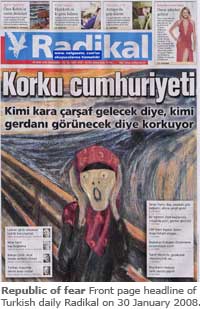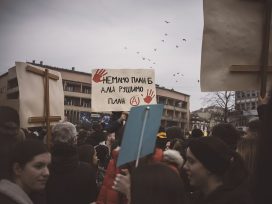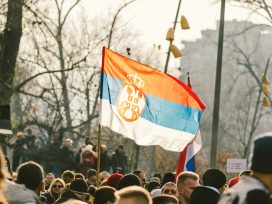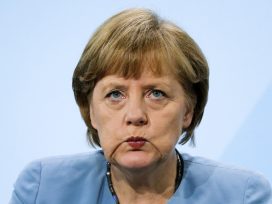
On 29 October 2007, Turkey’s Republic Day, President Abdullah Gül and chief of staff Yasar Büyükanit jointly took the salute at the military parade in Ankara. The PKK and the crisis on the Iraqi-Turkish border had put civilian and military leaders in the same boat again. Things appeared to have returned to normal.
Yet the feud between the military and civilian leadership has not been resolved. One month earlier, an image symbolising the standoff had been published on the front page of every Turkish newspaper: President Gül and his wife were being welcomed by a reception committee at Ankara airport; one soldier, however, had turned his back on the civilians. He was wearing a general’s uniform, and Mrs Gül a headscarf.
Because she declines to remove this symbol of devout Muslim womanhood, Turkey’s First Lady has been snubbed by the military. Her husband, meanwhile, avoids doing anything that might provoke his opponents. That is why, at receptions following his inauguration, alcoholic drinks were flowing, despite Ramadan.
The fact that the First Lady’s headscarf and the catering in the Presidential palace make the political headlines is purely symptomatic. The conflict between the Erdogan government, whose party does not deny its Islamist roots, and the military, which considers itself the spearhead of the Kemalist camp, has entered a new phase since summer 2007. The Justice and Development Party’s (Adalet ve Kalkinma Partisi – AKP) recent electoral victory and the election of a president who the Kemalists wanted to prevent at all costs has shifted the balance of power between the two camps. For the first time, the AKP controls the two top positions in the executive. Previously, the President was considered a custodian, whose task it was to defend the legacy of Atatürk and the “secular state”. Gül’s Kemalist predecessor Sezer was a strict legal expert who used his veto to block many of the AKP government’s initiatives.
Strong Kurdish support for the ruling party
It is no wonder, then, that the military wanted to prevent Erdogan’s foreign minister being elected to replace Sezer. And they seemed to be succeeding. On 27 April 2007, shortly before the crucial ballot in the parliament, the general staff announced on the Internet that the armed forces were determined “to defend the inviolable features of the Turkish Republic”. The announcement was accompanied by images of marching troops and generals posing in the mausoleum of the state’s founding father.
This “electronic intervention” had the desired effect: the constitutional court stopped Gül’s election with a ruling that amounted to the execution of an order. Yet the military leaders’ obstructionist tactics backfired: Erdogan reacted by bringing forward the parliamentary elections, which he won with a clear majority on 22 July. With 46.6 per cent of the vote, the AKP scored 12.2 more percentage points than in its 2002 election victory. Then the AKP sent its candidate into the fray again. On 28 August the new parliament voted in Abdullah Gül as head of state with an absolute majority of AKP votes.
Afterwards, the relationship between the president and the military commanders was like that between two states with frozen diplomatic relations. The military leadership even stayed away from the president’s inauguration ceremony. The situation only changed with the latest escalation of the Kurdish conflict. The fired-up nationalistic public mood meant that the government could not contradict the general staff’s plans to mobilise troops. With the parliamentary resolution authorising military deployment over the border in Iraq, Erdogan was actually underscoring parliament’s formal claim to be the highest instance of authority. Yet the vital question of to what extent the Turkish army can behave like a state within a state is still up in the air.
The balance of power between political and military leaders clearly did shift as a result of the July elections. However, it is disputed as to how much the general staff’s “electronic” intervention contributed to the AKP’s victory. Historian Ayhan Aktan believes that “frustration votes” in Anatolia were decisive: “The threat against Gül, who comes from Kayseri, was perceived as an insult.” Well-known Turkish electoral analyst Tarhan Erdem has a different perspective on it. Even before the military’s threat, the AKP rated between 45 and 50 per cent in polls carried out by his institute. While there was a boost in support after the threat, the AKP’s election victory was primarily due to good economic results.
The economy was also the decisive factor in eastern Turkey, says Metin Münir. The economics correspondent for Milliyet was sent by his newspaper to Gaziantep during the election campaign. This city on the Syrian border, with a population of over a million, is experiencing an economic boom, for which the locals credit the AKP. But the number of AKP votes also increased hugely in the country’s underdeveloped east. For the first time, people were seeing that their children were being given free schoolbooks and that they could visit a doctor or a hospital with one of the new “green cards”.
The ruling party got 56 per cent of the vote in eastern Anatolia. As a result, it also became the strongest party in the Kurdish regions – even stronger than the Kurdish Democratic Society Party (Demokratik Toplum Partisi – DTP), which, however, only put forward independent candidates. Münir believes that the military leaders’ intervention against Gül discredited the Kemalist Republican People’s Party (Cumhuriyet Halk Partisi – CHP), the AKP’s main rival. The CHP’s autocratic chairman, Deniz Baykal, had offered his services as the general staff’s parliamentary arm. With 20.8 per cent of the vote, the CHP fared far worse than it or the army had expected.
White Turks and Anatolian social climbers
From a sociological point of view, Erdogan’s victory marks a substantial shift in power within the Turkish upper and middle classes. According to election analyst Erdem, the AKP has now fully harnessed its conservative potential. It especially made gains with supporters of the traditional rightwing parties and Kurdish voters. If the Erdogan party can carry on exploiting this potential, it will stay in power for a long time, says Erdem.
Metin Münir believes this election victory signals the AKP’s irrevocable arrival in the establishment. Since it does not owe its increase in power to voters with an Islamic orientation, he argues, Prime Minister Erdogan would be foolish to scare off this new mass support base with “Islamist” policies. But will the head of the AKP behave rationally? Or will he pursue a “hidden agenda”, aimed at giving Turkey an Islamic bias, with President Gül to provide cover against attack? Hardcore Kemalists are convinced that the “Islamists” surrounding Erdogan want to destroy Atatürk’s secular, modern, democratic state and replace it with an Iranian- or Malaysian-style system. Hence they are watching every step the new government makes with a suspicion bordering on hysteria.
This explains why the “headscarf issue” is so controversial in the debate about a new constitution that began after Gül’s election. It is only superficially about the president’s wife’s headwear, and also not only about laicism (laiklik), in other words the secular state. It is primarily about the power of the Kemalist bloc, which not only includes the military, but also the whole “deep state” (derin devlet) and orthodox Kemalists in the judiciary, universities, and public administration.
This complex power bloc represents the interests of an elite, which until recently had unrivalled control over the country. Ayhan Aktar refers to an elite of “white Turks” that now feels threatened by the Anatolians, whom it has so far treated like poor relations. The Kemalist elite would only accept Erdogan, says Aktar, “if he shaved off his moustache, divorced his wife and was photographed with his arms around a model”.
Behind the cultural differences, Aktar sees thorny conflicts of interest between the old bourgeoisie and the “young” Anatolian social climbers, who have now seized another Kemalist bastion – the presidential palace in Ankara. This is why the issue of whether the Erdogan government will lift the ban on the headscarf (türban) in state universities as part of the planned constitutional reforms is being turned into a litmus test by military and civilian Kemalists in order to expose the upstarts’ intentions. At the end of September 2007, General Basbug, the army’s commander-in-chief and chief of staff elect, condemned the “anarchy of ideas” and threatened: “Laicism is the cornerstone of all Turkey’s values and principles and should not be put up for discussion by anyone”. The discussion, however, is already in full swing.
As for the question of how much room for manoeuvre the military still has after the AKP’s election victory, most Turkish observers would say that no one can really know for sure what the military are up to. On one hand, there has never been a ruling class that gave up power without a fight. On the other, the generals’ options have been limited by the “intervention of the people”, as Ahyan Aktar describes the AKP election victory.
Metin Münir also sees economic risks: the Turkish economic miracle is based on the influx of foreign capital. A military coup would drive away foreign investors, resulting in a massive payments deficit, which in turn would devalue the Turkish lira and cause the economy to falter.
At the moment, the military can only wait for the government to make mistakes – or force them to. That is why they are escalating the constitutional debate on the issue of laicism. However, since Erdogan and Gül profess their commitment to the secular state and Kemalism on an almost daily basis, the generals have to argue that even lifting the headscarf ban would threaten the system’s basic principles.
This tactic comes up against a twofold legal and social problem. The legal problem is that the türban ban in state universities is not embodied in any law or in the constitution. It was first introduced in 1989 after a ruling by the constitutional court that proclaimed laiklik as the “guiding principle of social and cultural life” that takes priority over all other constitutional principles. Therefore “no one may assert any right to individual liberty that is incompatible with the principle of laicism”. As a result, laiklik became the instrument used to quash basic rights – the right to a university education, for example.
The 1982 constitution is still imbued with the authoritarian spirit with which Atatürk abolished the fez, the traditional “Ottoman” headwear, with the so-called “Hat Law” in 1925. The idea behind this “reform” was evident in the warning of the future “Father of the Turks” to his children, “Civilisation is a terrible fire, which consumes those who disregard it”. This fire was not to be played with. The modernising government sent a battleship to the recalcitrant Black Sea town of Rize, where eight people were executed for opposing the Hat Law; in the whole of Turkey it was 86.
This dictatorial attitude has shaped the Turkish version of the secular state up to the present day. The version of laicism it propounds has nothing to with the way it is understood in France, Germany or Britain. Laiklik is a term charged with the idea of a struggle, which does not mean a separation of state and religion, but state control over religion. This role is carried out in Kemalist Turkey by the Presidency of Religious Affairs (Diyanet Isleri Baskanligi – DIB), a government institution to promote the Hanafi school of Sunni Islam.
The DIB is geared to the ideal of a homogenous Turkish nation as defined by the “Turkish-Islamist Synthesis”, which after the 1980 military coup became the state ideology. The DIB also regulates the compulsory – purely Sunni – religious education in state schools. In the view of political scientist Sahin Alpay, it functions as a state instrument for imposing Sunni identity. Non-Sunni taxpayers, like Jewish and Christian Turks, finance their own discrimination. The Alevis, the largest Muslim minority, are not recognized as belonging to an independent denomination, while non-Muslims are considered as “foreigners” and barred from working in the public sector.
For this reason, Kemalist laicism is also a misnomer, because it shields one specific religion. In the universities, which for the türban-clad women are off limits, there are more Atatürk icons hanging on the walls than there are crucifixes in the Vatican. And not only there: a monument to the state’s founding father can be found in nearly every village and his portrait on every banknote. Every Monday morning school children must line up in the playground and pledge their allegiance to Atatürk in unison. In school lessons the life of Kemal Atatürk is taught like the life of a saint. Anyone who questions this risks being taken to court for blasphemy under article 301 of the Turkish penal code, which makes “denigrating Turkishness” a criminal offence, where “Turkishness” and “Atatürk” are synonymous in the minds of Kemalist public prosecutors.
Naturally, the state’s saintly founder has his own place of pilgrimage too: the Atatürk Mausoleum in Ankara, to which half a million faithful followers made a pilgrimage on the sixty-ninth anniversary of his death. Even the time of Atatürk’s death is remembered by all Turks: every year, on 10 November at 9:05 am sharp, police sirens wail, whereupon many awestruck Turks stop what they are doing and salute the nearest national flag.
National security as compulsory school subject
What is more serious is that this personality cult has even been given constitutional status. According to the constitution’s preamble, Atatürk is the “immortal leader and incomparable hero”, whose “reforms and principles” and “conception of nationalism” are binding for the state and the nation: Atatürk’s children’s awestruck response is a constitutional principle.
No historian would dispute Atatürk’s services to his country: fighting off Greek invaders after WWI, he first formed a liberation army from the ruins of the Ottoman Empire, then a new country and finally a new nation. Yet the Kemalist nation-building process also had many fascist features. The journalist Mustafa Aykol lists among them the official “fantasies about the superiority of the Turkish race” and Atatürk’s posthumous appointment as the “eternal leader”.
From the very start, this authoritarian tradition was upheld by the army, which referred to itself as the “hearth of the nation” (yurdun ocagi). The army claims, in the words of former chief of staff Hilmi Özkök, to have brought about a transformation which “for Turkey was just as important as the Renaissance for the West”. Özkök is cited in a study written by a political scientist and two Turkish officers about the “symbiotic relationship” between the armed forces, the state and the people. According to this work, the Kemalist officer corps sees itself as the guarantor of social cohesion and therefore wants to “protect itself from external ideologies that could endanger the military’s homogenous outlook”.
After their last coup in 1980, this “self-perpetuating class of generals” installed a series of “listening posts in civil institutions” so that it could “detect and watch out for emerging dangers”. One example is the Council of Higher Education (YÖK), which has railed against the government in the current headscarf debate. The military’s ideology also makes “national security” a compulsory school subject, taught by uniformed officers and using textbooks written by the military. In addition to this there are repressive bodies such as the military police, which is answerable to the general staff, and the military justice system, which also has jurisdiction over civilians for certain “political” offences.
Fear of a creeping retürbanisation
Such an authoritarian model cannot be indefinitely prolonged; at some point society will stand up for itself. The Kemalist ploy is to always denounce such responses as “reactionary”, as if they would take Turkey back to the Middle Ages. Yet on the headscarf issue even the non-Kemalist Left is reacting nervously. There are intense discussions particularly about the danger of a creeping “retürbanisation”, as sociologist Serif Mardin is predicting. An empirical study by the Tesev Foundation shows, though, that such fears are exaggerated: the percentage of women covering their heads in public fell sharply between 1999 and 2006. According to the same study, the proportion of supporters of an Islamic legal system dropped over the same period from 22 to 9 per cent.
The Tesev study also shows, however, to what extent Mardin’s fears are realistic: if the headscarf ban were lifted, the number of traditionally dressed female university students is likely to rise initially, since the pressure of traditional families on their daughters would increase. This, however, does not mean that these students would pass on the pressure to “uncovered” fellow female students. And even if that were the case, the non-Kemalist Left – and the Turkish feminists – would have to answer a crucial question: do they not trust themselves to stand up for emancipatory ideas against conservative “peer pressure”, were the protection afforded by the Kemalist ban to disappear?
The fact that the current constitutional debate is fixated on the headscarf issue and the principle of secularism is not only down to the hard-line Kemalists, but to the government too. The AKP has failed to make the historical importance of this debate clear. Turkish society is deliberating the fundamental features of a constitution which, with a view to EU membership, also has to be post-Kemalist. There are three main issues at stake: first, how the military can be brought under civilian control and the “deep state” eradicated; second, what the relationship between the state and the individual should look like; and thirdly, how a constitution can take into account a people’s ethnic, religious and cultural diversity.
The 1982 constitution emphasises that the will of this supposedly homogenous nation enjoys “absolute supremacy”. Citizens’ fundamental rights are therefore only granted by the state, whose sovereignty over the people is guaranteed by the Kemalist military’s role as custodian. The difference between this and a democratic constitution is clear. The deputy chairman of the AKP, Mehmet Firat, put this very well in a speech made to the ambassadors of EU countries in Ankara: “While the current constitution was designed to protect the state from the people, the new constitution’s aim is to protect the individual from the state”.
The only question that remains is whether the AKP can and wants to accomplish its stated aim. Turkish observers are sceptical. Dogu Ergil, a legal expert, gives two reasons for this: first, under the “permanent supervision of the public administration and especially of the military”, the government does not feel strong enough “to demilitarise and liberalise the system”; second, and more importantly, the AKP itself is not immune to the “nationalist and authoritarian political culture in which it grew up”.
Ergen Özbudun is best placed to judge how the government’s plans look. The constitutional law and politics professor chaired the commission which drew up a new draft constitution for the AKP. He is free from any suspicion of having Islamist tendencies: in 2001 he represented the Turkish government before the European Court of Human Rights (ECHR) to explain the ban on the Islamist Refah party, in which Erdogan and Gül started their political careers. Özbudun acknowledges that Erdogan has changed his position. For him, the present-day AKP is a conservative party with a genuine orientation towards the European Union and its “Copenhagen Criteria”. He considers an Islamist “hidden agenda” to be a Kemalist delusion.
The draft constitution, which the committee of legal experts drew up under his chairmanship, is modelled on the spirit and the letter of the European Convention on Human Rights (ECHR) and the Court’s rulings. Freedom of opinion and speech, as well as the primacy of humanitarian international law, would be enshrined in the new constitution. Özbudun believes it is important that military court rulings can be reviewed by civilian courts. He also suggests an important step towards solving the Kurdish problem: if, instead of “the language” of the Republic, Turkish were to be defined as the “official language”, there would be scope within the law for other “non-official” languages.
Regarding the relationship between the state and religion, religious education, introduced in 1982, would no longer be a compulsory subject, but optional. Also, in line with the European Convention on Human Rights, the right to convert from one religion to another would stand in the constitution.
Özbudun has a clear opinion on the headscarf issue. In his view, the headscarf ban in universities is based on a “distorted conception of a secular state” and is an outright violation of human rights. However, his suggested constitutional text has a rather labyrinthine wording: every form of discrimination based on clothing must be prohibited “provided it does not contradict Atatürk’s principles and reforms”. The legal expert considers this a harmless caveat, as Atatürk’s reforms concerned only male, not female, headwear.
Here it becomes clear how cautiously the Özbudun committee moves in the minefield of Kemalist taboos. Nevertheless, the Erdogan government will hardly adopt all the items in the committee’s draft. The AKP has newly presented a reworked draft constitution to the parliament, due to be passed in summer 2008 and finally put to a referendum.
But it is clear that there is also resistance within the AKP. Professor Ali Bardakoglu, the leader of the Presidency of Religious Affairs (DIB), wants to keep compulsory religious education. His justification is that, by making it optional, “the differences between students” would increase. The theologian believes, then, that if the Sunni majority’s monopoly on doctrine were removed, the country’s homogeneity would be threatened! The fear of diversity is clearly no different as with the Kemalists.
The constitutional debate which the AKP has come up against after its election victory is proving more complex than one would think, given the polarisation between the weakened Kemalist power bloc and the strengthened government camp. In this debate, a third view is emerging that is critical of both the Kemalists and the AKP. The representatives of this third way are demanding not only more thorough democratisation, but also a willingness to secure Turkey’s religious pluralism and ethnic diversity in the statute books. This is just as much about overcoming discrimination against non-Sunni Muslims and other religions as discrimination against the Kurds.
Many independent intellectuals who supported and defended Erdogan and the AKP against the Kemalist establishment are today keeping a closer eye on the government and are slightly distrustful. One of these, Sahin Alpay, a respected columnist at the pro-government Zaman newspaper, is critical of the AKP’s relationship with the Alevis. The majority of Alevis voted for the Kemalist CHP in 2007 because they saw Erdogan as the leader of the Sunni party. In Alpay’s view, “democratic laicism” can only be achieved if the new constitution guarantees equality for the Alevis; pushing this measure through against the Sunni majority is Erdogan’s crucial “democratic mission”.
Ümit Kardas, a committed lawyer, has an even more radical constitutional vision. His scepticism towards the Kemalist military is based on his experiences as a military lawyer in Diyarbakir after the military coup in 1980. At that time he was so appalled by the repression of the Kurds that he resigned. Since then he has repeatedly instigated disputes with the military command. Currently Kardas is representing a case against OYAK, a giant company that has grown out of the military pension fund and that represents the economic backbone of the Turkish officers’ caste.
Ümit Kardas demands European-style laicism. He wants to completely do away with the DIB and the state’s control over religious communities, which would no longer be financed by taxpayers’ money, but by donations and foundations. These foundations would be protected from state intervention, regardless of whether they represent Muslims, Christians or other religions.
Basically, Kardas is outlining the framework for a post-Kemalist constitution, since he considers the 1982 constitution an “irreparable instrument” and its preamble the expression of a bygone age, in which the army commanded the nation. The military’s influence over society would be limited by introducing a form of civilian community service, thus implying the right to conscientious objection. The army and the police would not only be placed under civilian, in other words parliamentary control, but also be trained according to civilian principles, so that they would finally stop acting like the two “fists of the state” which either strike its citizens or threaten to do so.
However, such constitutional reforms would provoke the military even more than lifting the headscarf ban. That is why it is clear for Kardas that the Erdogan government will never propose such a radical programme. He does wonder, though, whether the AKP’s position is only shaped by tactical caution towards the Kemalist power bloc or is also a product of the authoritarian tendencies which Erdogan has already revealed a number of times (for example, by taking libel action against caricaturists who attack his weaknesses).
It one asks democrats like Ümit Kardas which political forces could push through a post-Kemalist constitution in Turkey, like most intellectuals he shrugs his shoulders with resignation. While an independent post-Kemalist Left is needed, it is nowhere to be seen. In the 2007 elections it was hoped that independent candidates would win some seats in the parliament. But the leftwing candidate did not even succeed in Istanbul, since the DTP Kurdish party presented its own candidate at the last minute, with the result that neither made it into parliament.
However, there are clear social problems and tensions which should have driven voters towards a leftwing party: the AKP has almost purely neoliberal policies dictated by the World Bank. The gulf between rich and poor is glaring and only sporadic attempts have been made to put together a social policy. Many families are heavily in debt, and the economic stability to which Erdogan owes his election victory is based on a continuous influx of foreign capital, which can be extremely volatile in times of crisis. What’s more, a crisis – given the prevailing nationalist mood stirred up by the Kurdish crisis – would only benefit the nationalist MHP, and of course the military and the “deep state”.
After Turkish army operations on the border with Iraq, military lawyers have started legal proceedings against eight soldiers who were kidnapped on 21 October by the PKK in northern Iraq and later released. They have been charged with “breach of duty” for “going (with their captors) to terrorist bases in northern Iraq”.
But the AKP is also using the public mood stoked by the Kurdish conflict. For example, the influential AKP politician Bülent Arinc announced that there has never been “a Turkish soldier who has surrendered to the enemy”. With these words he also shored up the martyr ideology of the army, which promotes dying for one’s country as a citizen’s highest duty In such a philosophy there is no room for a constitution that wishes to protect citizens from the state.







